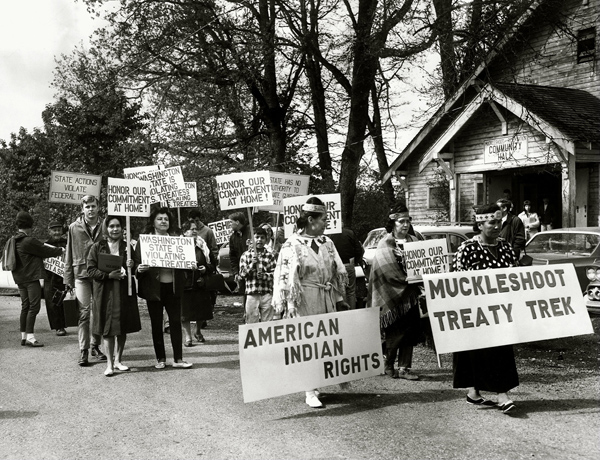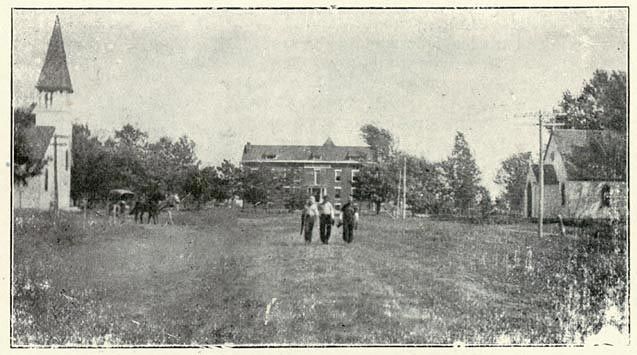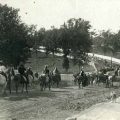
In 1966, the American federal government was beginning to wind down its policies intended to end federal involvement with Indian tribes, due to resistance from the tribes. Briefly described below are some events involving federal government policies and American Indians.
Commissioner of Indian Affairs
In the federal bureaucracy, Indian Affairs are administered by the Department of the Interior. In 1966 the Commissioner of Indian Affairs, a political appointee, was the person directly in charge of the Bureau of Indian Affairs. Following the dismissal of Philleo Nash from this position, Robert LaFollette Bennett, a member of Wisconsin’s Oneida tribe, became Commissioner of Indian Affairs. He was the second Native American to hold this position. His basic philosophy regarding Indian affairs was that the tribes should set their own priorities. The job of the Bureau of Indian Affairs was to help the tribes accomplish the goals which they had set. He felt that the Commissioner of Indian Affairs should be an advocate for the Indians rather than a promoter of government policies to Indians.
Unrecognized Indians
In the United States, there are many Indian tribes which are not recognized by the United States. A presidential task force reported that there were over 90,000 Indians in the eastern United States, 41 terminated bands in California, and over 200,000 urban Indians who struggled without the benefit of any Indian assistance programs. According to historian Mark Miller in his book Forgotten Tribes: Unrecognized Indians and the Federal Acknowledgment Process:
“The task force noted that these Indian peoples often went unnoticed and unidentified as Indians and were worse off than other Native Americans, both economically and psychologically.”
Indian Land
Congress responded to public concern regarding the loss of Indian land by ordering a federal investigation into land and trespass issues since the turn of the century on some 40 reservations.
Historic Preservation
Congress passed the National Historic Preservation Act (NHPA) which provides legal and administrative ways of identifying, evaluating, and protecting historic cultural resources. It established the foundation for historic preservation in the United States. In an article in the Plains Anthropologist, Kimball Banks, Signe Snortland, and Jon Czaplicki write:
“It explicitly recognizes that the federal government has a legal and fiduciary responsibility to ensure the preservation of the nation’s historic and archaeological heritage.”
Construction on federal lands now requires an assessment of cultural resources which might be affected. Action is required to preserve or record these cultural resources if they are deemed to be significant.
Termination
Following World War II and continuing through the 1960s, the federal government followed a policy known as Termination which sought to end the reservation system and any recognition of tribal sovereignty. In his chapter on Indian policy in The History of the Assiniboine and Sioux Tribes of the Fort Peck Indian Reservation, Montana, 1800-2000, David Miller writes:
“Reservations were considered the product of separate and unequal treatment, with little understanding of what treaties or negotiated executive agreements meant to Indian people.”
Historian Katrine Barber, in her book Death of Celilo Falls, summarizes termination this way:
“Termination required that the federal government relinquish its responsibility to Indian nations and shift those to state and county governments. Terminationists hoped to dismantle the reservation system and get the federal government ‘out of the Indian business.’”
Senator Henry Jackson of Washington wanted to revive termination long enough to terminate the Colville reservation in his state. Indian Commissioner Philleo Nash blocked this move. Jackson let the Secretary of the Interior know that either Nash was to be removed from office or the Department of the Interior would face a hostile Senate Interior Committee (chaired by Jackson). Nash was removed.
In Nebraska, 834 acres of the Northern Ponca Reservation were removed from federal trust status and the 442 tribal members were no longer legally considered Indians (that is, they could not participate in any federal Indian programs).
In California, the El Dorado Rancheria was terminated to make way for Highway 50. As a result, the El Dorado Rancheria Miwok Tribe became an unrecognized tribe.
In California, the Coast Miwok were terminated.
Sacred Site
Legislation was introduced in Congress which would have returned Blue Lake in New Mexico to Taos Pueblo. The area is sacred to the Pueblo. The bill did not pass.
Land Claims
Following World War II, the United States wanted to get out of the Indian business: that is, to severe all relationships with Indian tribes. In the spirit of assimilation and with the intent of reducing government’s role in Indian affairs, Congress passed the Indian Claims Commission Act in 1946 as a vehicle to extinguish all pending Indian claims and thus end the federal government’s obligation to provide support for the tribes. In other words, it would act as a kind of severance package which would help Indians to abandon their collective traditions and enter into American society as individuals.
Under the act, a tribunal would be created which would have a specialized knowledge of Indian claims and would therefore be able to work efficiently in adjudicating these claims. Initially, Congress had envisioned the commission completing its work in a period of five years. However, two decades later cases were still being heard. In 1966, one of these cases involved the Western Shoshone. In the nineteenth century, the federal government had expanded the provisions of the 1863 Ruby Valley Treaty to include all of the Shoshone in Oregon, Nevada, and Idaho even though most the tribes had not signed the treaty nor had they ever received any payment for the ceded land.
In 1966, most of the Western Shoshone did not want a cash settlement for the lands which had been taken from them, but simply wanted the lands returned to them. Against the wishes of the tribe, an attorney for the tribe and U.S. attorneys arbitrarily agreed that the extinguishment of Western Shoshone title to land in Nevada occurred on July 1, 1872 and therefore the value of this land was the value of the land in 1872.




Leave a Reply